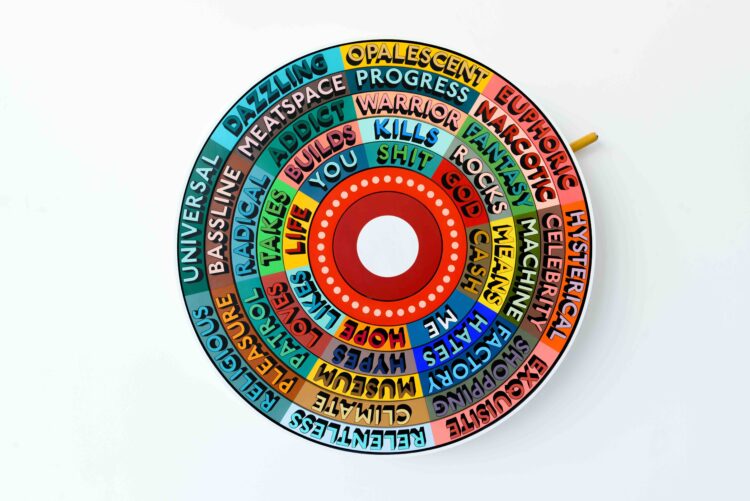Artist Tim Fishlock continues to find inspiration in the ‘cut-up’ technique first expounded in Tristan Tzara’s instructions on how to make a Dadaist poem. Following on from his 2018 work The Future Leaks Out; an eye-popping, interactive artwork comprised of rows of text-covered wooden blocks that aimed to make poets of us all; The Poem Will Resemble You is a psychedelic, carnivalesque, hand cranked generator of five word slogans.
The new work will be installed at London’s Hang-Up Gallery in Hoxton and will be available to view online via the newly launched Hang-Up website at www.hanguppictures.com.
The Poem Will Resemble You brings to mind the classic fairground wheel of fortune. 1069mm in diameter, it comprises six concentric rings that spin independently of each other. Five of the rings are divided into eight hand-painted segments containing a single word. A sixth, central ring is decorated with small circles to accentuate the Op art nature of the piece.
Pulling on the leather-bound lever positioned on the side of the artwork engages the internal mechanism and sets all six wheels in motion. Spinning at different speeds, the effect is discombobulating, as if one were on a dizzying ride at the funfair.
Each spin of the wheel results in the random generation of eight five-word slogans or phrases when read from the outer ring to the centre. There are 32,768 different permutations of these slogans.
It was only during the construction and engineering process for The Poem Will Resemble You that Fishlock came across the perpetual poems made by Tristan Tzara and Pablo Picasso in the 1920s. These volvelles comprised textual fragments on three superimposed paper disks with cut out ‘windows’. Two of the text disks rotate to create different combinations of words. The reader can create a seemingly endless number of poems through rotations of the wheels.
On the appeal of his disruptive approach to semantics Fishlock says, “In an era when attention spans are short and brevity is king, I’ve been working at saying as much as possible with as few words as possible. Aware that this approach can become a potential creative cul-de-sac, I discovered for myself the lyrical power and shift in consciousness that can be achieved by subverting the normal word order and its semantic meaning. It’s an impersonal method of inspiration and invention. As Burroughs put it, ‘You cannot will spontaneity but you can introduce the spontaneous factor with a pair of scissors.”
Careful consideration was given to the selection of words, which, like much of the artist’s work, allude to a fairly misanthropic, dystopian worldview. This establishes a striking contrast between the subject matter and a material form that is synonymous with TV quiz shows and funfairs.
For Fishlock, words and the glyphs that form them are a constant source of joy. The message can often be dark and misanthropic, but the method of delivery is always dazzling and playful.
Q: What is your inspiration and why do you do what you do?
A: I guess it’s my attempt to process the interminable tsunami of bullshit that’s bound my way, to purify it, distil it, until it resembles something vaguely pleasant to look at. Think of me as a sewage treatment plant.
Q: Can you tell us about your creative process?
A: Almost everything I do begins with words and bad drawings in notebooks as well as an ever-growing assemblage of words and phrases in Notes on my phone.
I like to work to a theme, producing series of works around an idea that interests me at the time. I’ve always loved experimenting with materials, so I often try to bend an idea to suit a material or technique that I’d like to employ.
Q: What is the reason behind your fusion of typography, social media culture and the essence of narcissism in your works?
A: I did a degree in English Literature so words have always inspired me. I’m interested in both the semantics and visible representation of language. Amongst many other things, I spent some years as a graphic designer, so have some training in typography – I’m no expert though!
Social media is the defining form of communication amongst humans of the last twenty years. When all things are considered, it would be hard to conclude that social media has been anything but ruinous for our species. Ronald Wright writes in A Short History of Progress that ‘we are running twenty-first-century software on hardware last upgraded 50,000 years ago or more’. That idea of a species in thrall to but ultimately subjugated by the technology it creates is central to a lot of my work.
I’m a painfully introspective person and I’ve always been keen to incriminate myself in the inherent criticism present in much of my output. Coming to terms with our own imperfections seems to me to be wholly essential at this moment in our history. I’ve no interest in using social media myself (my daughter runs my Instagram account) as that idea of projecting a perfect version of your self is anathema to me.
